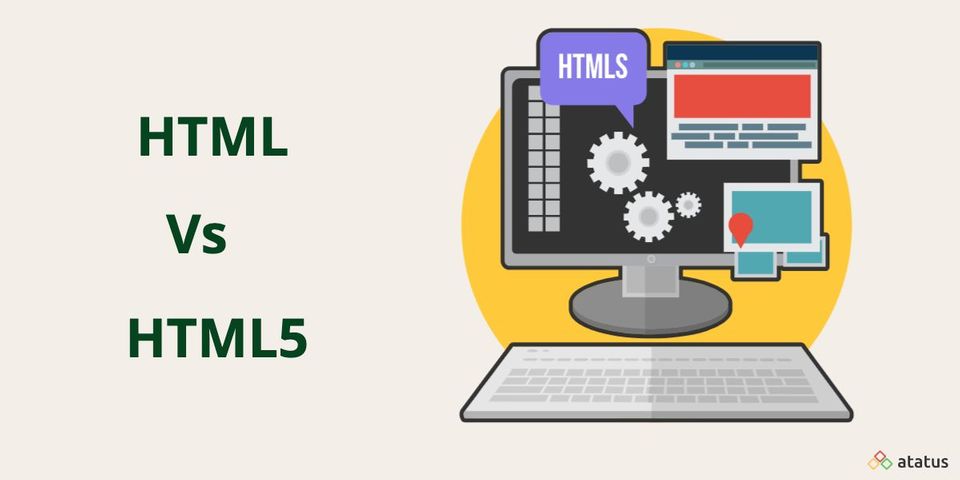HyperText Markup Language (HTML) is the most popular markup language for building online pages and apps. It is the primary language used on the World Wide Web (WWW). In web development, developers use the language to create web page elements, including text, hyperlinks, and multimedia files. It has predefined elements and tags for categorizing information and describing the structure of pages. However, HTML 5.2, released in 2017, is the most recent version of HTML. In this article, we will discuss the differences between HTML and HTML5, as well as the benefits of HTML5 for developers and end users.
HTML vs. HTML5:
Both HTML and HTML5 are hypertext markup languages that are primarily used to create online pages and apps. HTML5 is the most recent version of HTML and includes new markup language features such as multimedia, new tags and elements, and new APIs. HTML5 also allows audio and video.
Features of HTML:
- HTML does not provide native audio or video functionality.
- It only allows vector graphics when combined with other technologies such as Flash, VML, or Silverlight.
- It allows for inline MathML and SVG in text, but only with restrictions.
- It does not enable users to draw forms like circles, triangles, or rectangles.
- HTML only uses the browser cache and cookies to store data temporarily.
- JavaScript and the browser interface execute on the same thread.
- In HTML, the document type declaration is longer.
- Longer character encoding declaration in HTML and uses the ASCII character set.
- It is compatible with nearly all browsers.
- It is built on the Standard Generalized Markup Language (SGML).
Features of HTML5:
- HTML5 offers native audio and video capability.
- It can handle SVG (Scalable Vector Graphics), Canvas, and other virtual vector graphics.
- It allows inline MathML and SVG in text.
- HTML5 enables users to create forms like circles, triangles, and rectangles.
- It stores data temporarily using web SQL databases, local storage, and the application cache.
- JavaScript and the browser interface execute in separate threads.
- The document type statement is shorter in HTML5.
- The character encoding statement is shorter in HTML5, and it uses the UTF-8 character set.
- It is only compatible with newer browsers, as there are many new tags and components that only a few browsers support.
- It has improved parsing rules, resulting in better compatibility.
Changes in HTML5:
In addition to the features listed in the table above, HTML5 has introduced several new elements, including nav, audio, figcaption, progress, command, time, datalist, video, figure, meter, data, section, time, aside, canvas, summary, rp, rt, details, wbr, header, footer, keygen, embed, article, hgroup, bdi, mark, output, source, track, section, ruby, and many more.
- Some elements were eliminated, including isindex, noframes, acronym, applet, basefont, dir, font, frameset, big, center, strike, and tt.
- New form controls include dates and times, email, phone number, range, url, search, color, and datalist.
- Numerous additional components, such as video, navigation, aside, progress, canvas, section, meter, and time are there.
- New APIs provide a variety of features, including drag-and-drop support, browser history management, and reading and locking screen orientation status.
- New properties in HTML5 include async, manifest, sandbox, sourcedoc, and reversed.
- New global properties include hidden, role, spellcheck, and translate.
Benefits of HTML5:
- It is mobile-friendly and simple to use.
- Web pages provide a variety of colors, tints, and font types.
- HTML5 is compatible with any web browser.
- It supports client-side databases.
- HTML5 has increased performance and security, as it allows storage across several browsers.
- Suitable for cross-stage portable applications.
- HTML5 improves the accessibility and inspection of HTML documents with semantic elements and ARIA.
Which is Better: HTML or HTML5?
As we can see in this article, HTML5 has additional features and functionalities over HTML, such as audio and video support through tags, drag and drop functionality, browser compatibility, and so on. Therefore, because it is the most recent version of HTML, it is advised to adopt HTML5 for easy and quick implementation in contrast to HTML.
Conclusion:
We are now aware of the differences between HTML and HTML5, even though they go hand in hand. In simple terms, HTML is a hypertext markup language that is used in the web development by hashlogics process to create web pages and websites (combinations of web pages). It was introduced in 1993 by Tim Berners-Lee, whereas HTML5 is also a hypertext markup language but it is upgraded and the latest version of HTML was introduced in 2008 with some additional features like support for audio and video with the help of their specified tags and many more functionalities like enabling drag and drop feature, running Overall, HTML and HTML5 are markup languages. HTML5 just includes some new functionality because it is an improved version.
